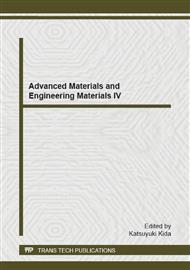[1]
Yarkovets A.N., Long life bolted joining and riveting technology in aircraft structures, Translated by G.L. ZHANG, Aviation Industry Press, Beijing, (1991).
Google Scholar
[2]
Z.Q. CAO, H. LIU. Electromagnetic riveting technology, Journal of Plasticity Engineering. 14 (2007) 120-123.
Google Scholar
[3]
J.Q. WANG, Z.Q. CAO, Study on application of large diameter and high-Interference bolt installation, Aeronautical Manufacturing Technology. 412 (2012) 87-89.
Google Scholar
[4]
X.H. GAO, Z.Q. CAO, Quality analysis of the interference-fit Hi-lock bolts manufactured by titanium alloy using stress wave, Mechanical Science and Technology for Aerospace Engineering. 32(2012) 138-40.
Google Scholar
[5]
G.K. XU, M.H. GAO, Q.D. XIAO, Development, equipment research and application of electromagnetic riveting, Aeronautical Manufacturing Technology. 371(2010) 38-41.
Google Scholar
[6]
A.I. Yarkovets, Long life bolted joining process in aircraft structures, Aviation Industry Press, Beijing, 1991, pp.100-101.
Google Scholar
[7]
Chinese academy of aviation science and technology, Handbook of aircraft structure anti-fatigue and anti-fracture strengthen technology, Aviation Industry Press, Beijing, (1993).
Google Scholar
[8]
Q.C. ZHANG, Y.B. WANG, L.H. ZHAI, Advanced aircraft mechanical joint technology. Weapon Industry Press, Beijing, (2000).
Google Scholar
[9]
G.F. SHE, H. TAO, An improved understanding of interference fit strength technique, Acta Aeronautica et Astronautica Sinica, 12(1990)516-517.
Google Scholar
[10]
J.F. JIANG, H.Y. DONG, Y.L. KE, Maximum interference fit size of Hi-lock bolted joints. Journal of Mechanical Engineering, 49(2013) 145-152.
DOI: 10.3901/jme.2013.03.145
Google Scholar
[11]
Clarence R. Smith, Interference fasteners for fatigue-life improvement, SESA Annual Meeting, Cleveland, Ohio, October 28-30, (1964).
Google Scholar
[12]
Gregory A. Shoales, Lt Col Scott A, Fawaz, E-8/B-707 wing station 320 transition fit fastener finite element analysis, USAFA TR 04-04, Center for Aircraft Structural Life Extension (CAStLE), Department of Engineering Mechanics, HQ USAFA, (2004).
DOI: 10.21236/ada430478
Google Scholar
[13]
Johan Ekh, Multi-fastener single-lap joints in composite structures, Department of Aeronautical and Vehicle Engineering, Royal Institute of Technology, SE–100 44 Stockholm, Sweden, May (2006).
Google Scholar
[14]
F. Pellenkoft , J.J. Homan, Experimental and analytical investigations on the crack initiation and crack propagation behavior of mechanically fastened FML Joints, First International Conference on Damage Tolerance of Aircraft Structures, The Netherlands, (2008).
Google Scholar


